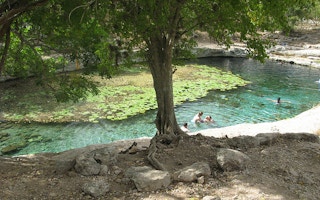The Mayan civilisation in what is now Mexico perished more than a thousand years ago not just because of drought, but perhaps because of too much reliance on water in reservoirs.
The story of the rise and decline of ancient civilisations has resonance for today. And researchers at Vienna University of Technology in Austria, who modelled what they calculate must have been the pattern of events, have confirmed, once again, that prolonged drought probably brought a culture and a people to collapse.
But, they warn, the story is not a simple one. The Mayans may have been, in a sense, victims of their success in confronting drought. Their own irrigation technology may have made them more vulnerable at a time of population growth and extended drought.
“Water influences society and society influences water,” says Linda Kuil, a socio-hydrologist at the Centre for Water Resource Systems in Vienna and lead author of a study published in Water Resources Research journal.
“
When it comes to scarce resources, the simplest solutions might turn out to be superficial and not always the best ones.
Linda Kuil, socio-hydrologist, Centre for Water Resource Systems
Response to drought
“The water supply determines how much food is available, so that in turn affects the growth of populations. Conversely, the population increases may interfere with the natural water cycle through the construction of reservoirs, for example.”
She and colleagues set out to model not just rainfall, but the pattern of a society’s response to precipitation and drought. They were not the first to do so. Drought and climate change have been linked to the collapse of the Assyrian empire 2,700 years ago, and to the disaster that overtook the Bronze Age rulers of the eastern Mediterranean.
Climate shifts have been linked to the making of the Chinese empire and the advance of the Mongol hordes in the 13th century. And climate change has also been implicated in modern conflict.
But fallen European and Asian civilisations left testimony in the form of written records or enduring mythology. The Mayans left only their stone structures in Yucatan in Mexico as evidence that they had been here at all.
Water on tap
The Vienna researchers think that the Mayan people coped with drought by building reservoirs to tide them over the crisis. Populations could be expected to decline in a drought, but would continue to grow if water was on tap.
Paradoxically, this may introduce vulnerability: if population grows, but the water management system stays the same, then a prolonged dry spell could be devastating.
And this, the researchers think, could be enough to explain the decline. Their own model delivers what they called “plausible feedbacks” between a society and the water resources it believes itself to be managing, to show that a modest reduction in rainfall could lead to an 80 per cent population collapse.
“When it comes to scarce resources, the simplest solutions might turn out to be superficial and not always the best ones,” Kuil says.
“You have to change people’s behaviour, reassess society’s dependency on this resource and reduce consumption – otherwise society may in fact be more vulnerable to catastrophes rather than safer, despite these clever technical solutions.”
This story was published with permission from Climate News Network.










